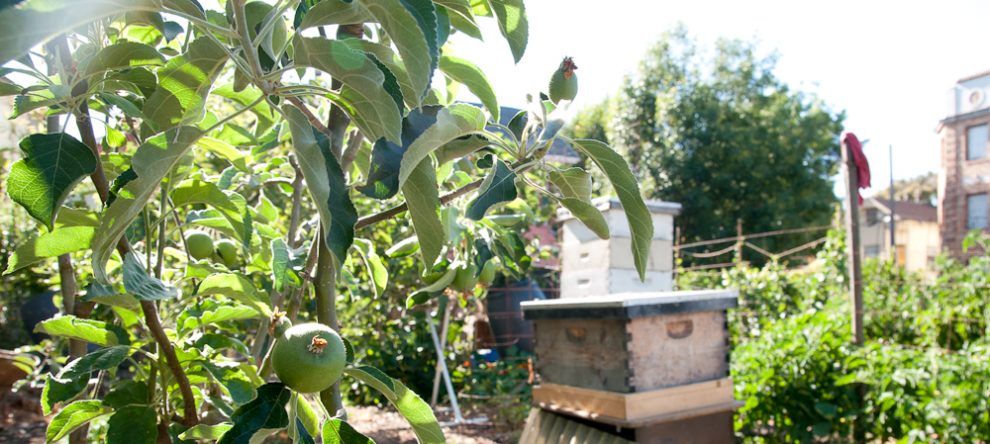Hello! I tried to submit this to the NYTimes Op-Ed pages, but they had too many damn Thanksgiving opinions, so here it is, on my humble blog….
Four years ago, I raised my first Thanksgiving turkey on my urban farm in Oakland, CA. My reasoning was the following: I wanted to eat organic, free-range turkey but didn’t have a lot of money, so I decided to do it myself. With this in mind, I did what any urban farmer does: I logged onto the internet and bought a bargain-priced assortment of day-old poultry. A few weeks later I received a peeping box through the US Post Office, my assortment was called the Homesteader’s Delight. The baby turkeys—poults–looked like chicks: fuzzy, adorable, with a little pucker of skin on their heads. As the poults grew, that pucker turned into a dangling snood, and I grew fond of this most American of poultry. They had a curiosity, an openness toward other creatures, including my dumbfounded neighbors. One of the denizens of my street, a strict vegan, even named the turkeys in a bid to turn them into pets, not dinner.
The turkeys lived on my farm for six months. They had a good life and were fed well. They roamed freely. And on one cold November day, one of my turkeys went from live animal to the celebratory centerpiece on the Thanksgiving table. My initial goal, to save money, was a colossal failure: I ended up spending about $100 each on feed for the birds, making it not so cost-effective. Instead of saving money, I learned a few lessons about what it means to eat meat. One surprise was raising a turkey made me feel deeply connected to our human ancestors. A rather post-modern experience—raising a turkey in the city—tied me to the first people who domesticated the animals that appear in farms today. I became part of a long line of historical animal husbandry. Another lesson learned: meat does involve killing. This is so obvious, but it’s a reality that most meat eaters avoid recognizing. Vegetarians and vegans argue that meat is murder. It’s not exactly murder, though, as my turkey wasn’t killed with hatred or malice, but with respect and thanks. A final lesson was that the most important part of animal husbandry isn’t the day of that animal’s death, something we Americans fixate on. No, it is the day-in, day-out of the turkey’s half-year lifetime that should be focused upon. Did that turkey get the chance to run about, to chirp and call, to feel safe, have access to plenty of food, and most of all to be a turkey? The fact that I could answer in the affirmative to these questions, made me feel like I did right by that turkey. And I did right by myself and family and friends, as that turkey was the most flavorful, tender, juicy bird I had ever eaten. I had a deep connection to the turkey that was served for dinner; I had the story of the turkey’s life to share at the table.
This November at my friend’s urban farm in Austin, Texas, I had the honor of teaching a handful of curious students how to raise their own turkeys in the city—something I have done every year since that first time four years ago. I like to point out that anyone who has room for a few chickens usually has enough space to raise a turkey or two. After teaching basics about coops and predator protection, feed and water, I demonstrated how to humanely kill, then pluck and eviscerate a beautiful Rio Grande turkey. As the class helped pluck away the bird’s feathers—the key moment when the bird becomes recognizable as meat–the group grew quiet and reverential. I taught the class because I want people to understand what it means to eat meat. It means a life is lived and a life is taken. Vegetarians and vegans acknowledge this fact more readily than carnivores. Instead of turning away from this reality, I would like people this Thanksgiving to look even closer, to examine where their turkey comes from, how it lived, and how it died. A small-scale turkey farmer friend of mine says she cries every November when it comes time to harvest their birds. Meat is precious. At the end of my class, my students assured me they would never think of turkey in the same way again. They now had a more complete vision of their meal, and they were eager to share that story.
P.S. I will be braising my turkey Edith (pictured, preparing for turkey sex, on bottom), who was slaughtered as part of last year’s turkey class. She wasn’t able to hatch out any chicks, and grew to be an older bird, and will make a fine turkey soup. Thank you Edith!




